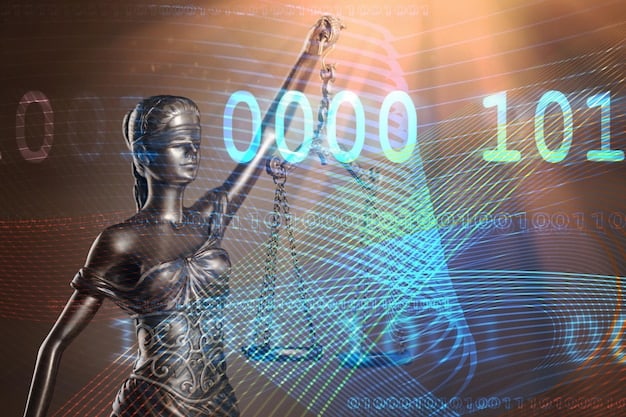Analyzing AI’s Algorithmic Bias: Regulations for Fairness in the US

Analyzing the Impact of Artificial Intelligence on Algorithmic Bias: What Regulations Are Needed to Ensure Fairness? examines the ethical concerns surrounding AI systems, particularly their propensity to perpetuate societal biases when applied in the US, and explores potential regulatory frameworks to mitigate discriminatory outcomes and ensure equitable AI implementation.
Artificial Intelligence (AI) is rapidly transforming various sectors in the United States, from healthcare and finance to criminal justice. However, the increasing reliance on AI systems has brought to light a critical issue: algorithmic bias. Analyzing the Impact of Artificial Intelligence on Algorithmic Bias: What Regulations Are Needed to Ensure Fairness? is essential to ensure that these powerful tools do not perpetuate existing societal inequalities.
Understanding Algorithmic Bias in AI
Algorithmic bias occurs when a computer system reflects the implicit values of the humans who created it, or when the algorithm is trained on incomplete or skewed data. This can lead to AI systems making decisions that unfairly discriminate against certain groups, undermining principles of justice and equality. Understanding how this bias arises is the first step toward addressing it.
Sources of Algorithmic Bias
Algorithmic bias isn’t a simple, monolithic problem. It stems from a variety of sources, often working in concert to produce unfair outcomes.
- Data Bias: AI models are trained on data, and if that data reflects existing societal biases, the model will learn and amplify those biases. For example, if a facial recognition system is primarily trained on images of white faces, it may be less accurate when identifying people of color.
- Sampling Bias: This occurs when the data used to train the algorithm does not accurately represent the population the algorithm is intended to serve.
- Algorithmic Design Choices: The choices that developers make when designing an algorithm can also introduce bias, such as the selection of features or the weighting of different variables.
- Human Bias: Preconceived notions and prejudices held by the developers themselves can inadvertently be embedded in the algorithm.
Recognizing these sources is crucial for developing strategies to mitigate algorithmic bias. Without a clear understanding of where the bias originates, it is difficult to create effective interventions.

Addressing these biases requires a multi-faceted approach, including careful data curation, algorithmic transparency, and ethical oversight in AI development and deployment. Failing to address these issues can have far-reaching consequences, reinforcing systemic inequalities and eroding public trust in AI technologies.
The Impact of Biased AI on Social Justice
The social justice implications of algorithmic bias are far-reaching, affecting areas such as employment, education, criminal justice, and healthcare. When AI systems perpetuate biases, they can reinforce existing inequalities, making it harder for marginalized groups to access opportunities and fair treatment. Understanding these impacts is critical in advocating for responsible AI development and deployment.
Employment
AI-powered recruitment tools are increasingly used to screen job applicants, but these systems can perpetuate bias if they are trained on historical data that reflects existing disparities in the workforce. For example, an AI system trained on a dataset where men are disproportionately represented in leadership positions may be less likely to recommend female candidates for those roles.
Criminal Justice
In the criminal justice system, AI is used for risk assessment, predicting the likelihood that an individual will re-offend. However, studies have shown that these systems can be biased against certain racial groups, leading to harsher sentences and perpetuating systemic inequalities. This issue has raised serious concerns about fairness and due process in the application of AI in legal contexts.
- Disproportionate Impact: Biased AI systems in criminal justice can lead to disproportionately negative outcomes for minority communities.
- Opacity and Lack of Transparency: The complexity of AI algorithms can make it difficult to understand how decisions are being made, hindering accountability.
- Erosion of Trust: When communities perceive AI systems as biased and unfair, it erodes trust in the justice system.
Mitigation strategies include improving data quality, conducting regular audits of AI systems, and ensuring transparency in algorithmic decision-making.
By examining the real-world consequences of biased AI, it becomes clear that regulations and ethical guidelines are essential to prevent these harms and promote fairness and equity. The ongoing development and refinement of AI technologies must prioritize the well-being of all members of society, especially those who are most vulnerable to discrimination.

The Need for AI Regulations in the US
Given the potential for AI to perpetuate and amplify societal biases, there is a growing consensus that regulations are needed to ensure fairness and accountability. These regulations should address various aspects of AI development and deployment, from data collection and algorithm design to transparency and oversight. The US context presents unique challenges and opportunities in this regulatory landscape.
Key Areas for Regulation
Effective AI regulation needs to cover several critical areas to address the multifaceted nature of algorithmic bias.
- Data Governance: Establishing guidelines for data collection, storage, and use to prevent the introduction of bias. This includes requirements for data minimization, privacy protection, and regular audits.
- Algorithmic Transparency: Ensuring that AI algorithms are understandable and explainable, so that their decisions can be scrutinized and challenged.
- Accountability Mechanisms: Establishing clear lines of responsibility for the outcomes of AI systems, including mechanisms for redress when harm occurs.
- Fairness Metrics: Developing standardized metrics for assessing the fairness of AI algorithms and requiring regular audits to ensure compliance.
These regulations should also be adaptable, evolving as AI technologies advance to address new challenges and ethical considerations that may arise. A comprehensive regulatory approach is essential to foster trust in AI systems and prevent them from undermining social justice principles.
Potential Regulatory Frameworks
Several regulatory frameworks have been proposed to address algorithmic bias in AI, each with its own strengths and limitations. These frameworks range from industry self-regulation to comprehensive government oversight. Exploring these options can help inform the development of effective AI regulations in the US.
Industry Self-Regulation
Some argue that the AI industry should be responsible for self-regulation, developing and enforcing its own ethical guidelines and standards. While this approach has the advantage of flexibility and responsiveness, it may lack the teeth needed to ensure widespread compliance and address systemic biases.
Government Oversight
A more robust approach involves government oversight, with regulatory agencies setting and enforcing standards for AI development and deployment. This could include establishing an AI regulatory body, similar to the Food and Drug Administration (FDA), that is responsible for approving AI systems and ensuring they meet certain fairness and safety standards. This approach offers the potential for greater accountability and enforcement, but may also face challenges related to bureaucratic delays and regulatory capture.
A hybrid approach, combining elements of industry self-regulation with government oversight, may offer the best balance between flexibility and accountability. This could involve industry developing ethical guidelines and best practices, while government agencies provide oversight and enforcement, setting minimum standards and addressing systemic issues.
Challenges in Implementing AI Regulations
Implementing effective AI regulations is not without its challenges. These challenges include technical complexity, the rapid pace of innovation, and the need to balance innovation with fairness and accountability. Addressing these challenges requires a collaborative approach, involving experts from a variety of fields.
Technical Complexity
AI algorithms can be incredibly complex, making it difficult to understand how they work and identify potential sources of bias. This requires regulators to have a high level of technical expertise and access to resources for auditing and testing AI systems.
Rapid Innovation
AI technologies are evolving rapidly, making it difficult for regulations to keep pace. This requires a flexible and adaptable regulatory framework that can be updated as new technologies emerge. It also requires ongoing collaboration between regulators, industry, and academia to stay ahead of the curve.
Overcoming these challenges requires a forward-thinking approach to AI regulation, one that prioritizes collaboration, transparency, and ongoing learning. By addressing these challenges head-on, policymakers can ensure that AI technologies are developed and deployed in a way that promotes fairness, accountability, and social justice.
The Role of Ethics in AI Development
In addition to regulations, ethics plays a crucial role in ensuring fairness in AI systems. Ethical considerations should be integrated into every stage of AI development, from data collection and algorithm design to deployment and monitoring. This requires a shift in mindset, with AI developers recognizing their responsibility to create systems that are not only effective but also ethical and fair.
Ethical Guidelines for AI Developers
Several organizations have developed ethical guidelines for AI developers, offering a framework for responsible AI development. These guidelines typically include principles such as:
- Fairness: Ensuring that AI systems do not discriminate against certain groups or individuals.
- Transparency: Making AI algorithms understandable and explainable.
- Accountability: Establishing clear lines of responsibility for the outcomes of AI systems.
- Privacy: Protecting individuals’ privacy and data rights.
By adhering to these ethical guidelines, AI developers can help ensure that their systems are used for good and do not perpetuate harm. However, ethical guidelines are not enough on their own. They need to be complemented by regulations that provide clear standards and enforcement mechanisms.
Fostering a culture of ethical AI development requires ongoing education, training, and collaboration. By promoting ethical awareness and responsibility, we can create AI systems that reflect our values and serve the best interests of all members of society.
| Key Point | Brief Description |
|---|---|
| 🤖 Algorithmic Bias | AI systems can reflect societal biases, leading to unfair outcomes. |
| ⚖️ Regulation Need | Regulations are essential to ensure fairness, accountability, and ethical AI development. |
| 🛡️ Ethical Role | Ethics must be integrated into every stage of AI development. |
| 🎯 Key Areas | Data governance, algorithm transparency, and accountability mechanisms are key. |
FAQ
▼
Algorithmic bias refers to the systematic and repeatable errors in a computer system that create unfair outcomes, such as privileging one arbitrary group of users over others. It often occurs due to flawed assumptions in the algorithm.
▼
Algorithmic bias perpetuates and amplifies existing societal inequalities, hindering opportunities for marginalized groups. It undermines trust in AI systems and can lead to discriminatory and unjust outcomes across various sectors.
▼
Key areas affected by AI bias include employment, education, criminal justice, and healthcare. In each of these areas, biased AI systems can reinforce existing disparities and create new barriers to access and fairness.
▼
Regulations should focus on data governance, algorithmic transparency, and accountability mechanisms. This includes guidelines for data collection, algorithm design, and regular audits to ensure compliance with fairness standards.
▼
Ethical guidelines provide a framework for responsible AI development, emphasizing principles such as fairness, transparency, and accountability. When combined with regulations, these guidelines help ensure AI systems are developed and deployed ethically.
Conclusion
In conclusion, analyzing the impact of artificial intelligence on algorithmic bias reveals the urgent need for regulations and ethical practices in AI development within the US. Addressing this issue requires a collaborative, forward-thinking approach that prioritizes fairness, transparency, and accountability to ensure equitable outcomes for all members of society.





